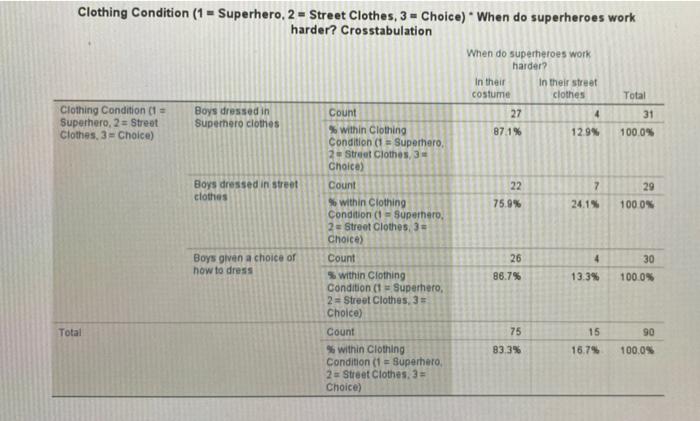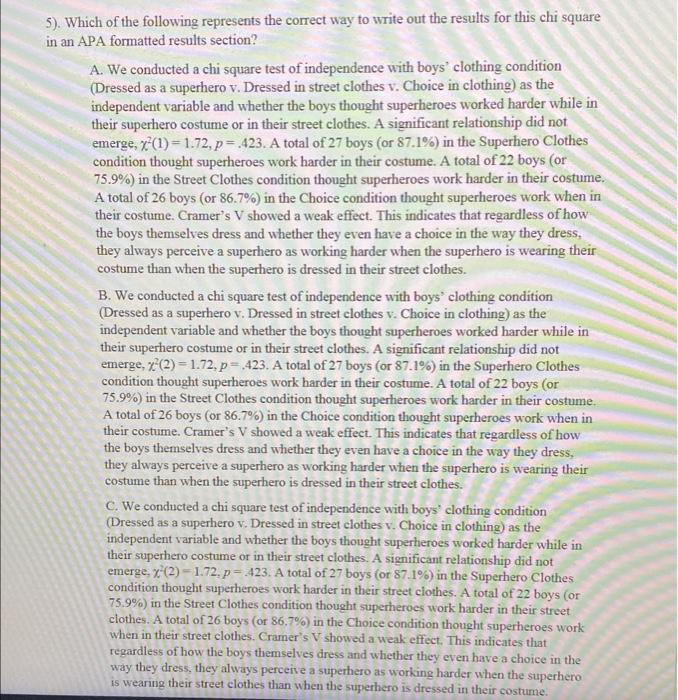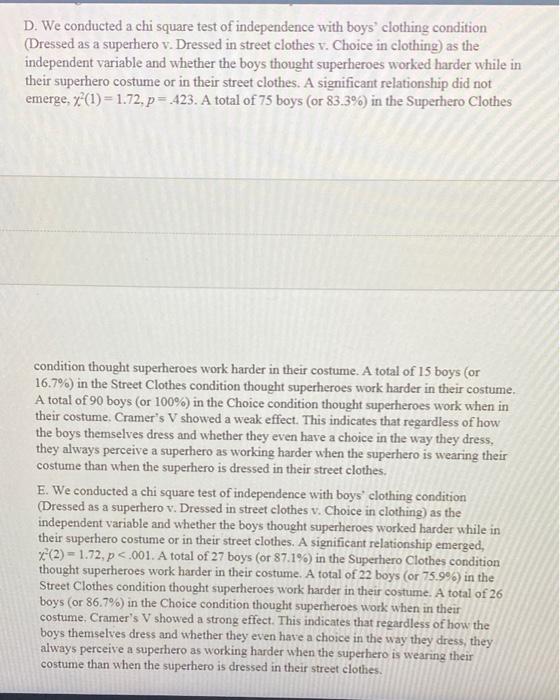Help with this 2 questions please

Clothing Condition (1= Superhero, 2= Street Clothes, 3= Choice) When do superheroes work harder? Crosstabulation When do superheroes work harder? In their In their street costume clothes Total Boys dressed in Count 31 Clothing Condition (1= Superhero, 2= Street Clothes, 3= Choice) Superhero clothes % within Clothing 100.0% Condition (1= Superhero, 2 Street Clothes, 3 Choice) Count 29 Boys dressed in street clothes % within Clothing 100.0% Condition (1= Superhero, 2= Street Clothes, 3= Choice) Count 30 Boys given a choice of how to dress % within Clothing 100.0% Condition (1= Superhero, 2= Street Clothes, 3= Choice) Total Count 90 100.0% % within Clothing Condition (1= Superhero, 2= Street Clothes. 3= Choice) 27 87.1% 22 75.9% 26 86.7% 75 83.3% 4 12.9% 7 24.1% 4 13.3% 15 16.7% Chi-Square Tests Value 1.722 Asymptotic Significance (2-sided) Pearson Chi-Square 2 Likelihood Ratio 1.644 2 003 1 Linear-by-Linear Association N of Valid Cases 90 a. 1 cells (16.7%) have expected count less than 5. The minimum expected count is 4.83. Symmetric Measures Value Nominal by Nominal Phi Cramer's V N of Valid Cases 138 .138 90 423 439 955 Approximate Significance .423 .423 4). How many boys in the Superhero Clothes condition thought superheroes work harder when in costume than when in street clothes? How many boys in the Street Clothes condition thought superheroes work harder when in costume than when in street clothes? How many boys in the Choice condition thought superheroes work harder when in costume than when in street clothes? A. A total of 26 boys (or 86.7%) in the Superhero Clothes condition thought superheroes work harder in their costume. A total of 22 boys (or 75.9%) in the Street Clothes condition thought superheroes work harder in their costume. A total of 27 boys (or 87.1%) in the Choice condition thought superheroes work when in their costume. B. A total of 27 boys (or 87.1%) in the Superhero Clothes condition thought superheroes work harder in their costume. A total of 22 boys (or 75.9%) in the Street Clothes condition thought superheroes work harder in their costume. A total of 26 boys (or 86.7%) in the Choice condition thought superheroes work when in their costume. C. A total of 27 boys (or 87.1%) in the Superhero Clothes condition thought superheroes work harder in their street clothes. A total of 22 boys (or 75.9%) in the Street Clothes condition thought superheroes work harder in their street clothes. A total of 26 boys (or 86.7%) in the Choice condition thought superheroes work when in their street clothes. D. A total of 31 boys (or 100%) in the Superhero Clothes condition thought superheroes work harder in their costume. A total of 29 boys (or 100 %) in the Street Clothes condition thought superheroes work harder in their costume. A total of 30 boys (or 100%) in the Choice condition thought superheroes work when in their costume. E. A total of 75 boys (or 83.3%) in the Superhero Clothes condition thought superheroes work harder in their costume. A total of 15 boys (or 16.7%) in the Street Clothes condition thought superheroes work harder in their costume. A total of 90 boys (or 100%) in the Choice condition thought superheroes work when in their costume. 5). Which of the following represents the correct way to write out the results for this chi square in an APA formatted results section? A. We conducted a chi square test of independence with boys' clothing condition (Dressed as a superhero v. Dressed in street clothes v. Choice in clothing) as the independent variable and whether the boys thought superheroes worked harder while in their superhero costume or in their street clothes. A significant relationship did not emerge, 7(1)= 1.72, p= .423. A total of 27 boys (or 87.1%) in the Superhero Clothes condition thought superheroes work harder in their costume. A total of 22 boys (or 75.9%) in the Street Clothes condition thought superheroes work harder in their costume. A total of 26 boys (or 86.7%) in the Choice condition thought superheroes work when in their costume. Cramer's V showed a weak effect. This indicates that regardless of how the boys themselves dress and whether they even have a choice in the way they dress, they always perceive a superhero as working harder when the superhero is wearing their costume than when the superhero is dressed in their street clothes. B. We conducted a chi square test of independence with boys' clothing condition (Dressed as a superhero v. Dressed in street clothes v. Choice in clothing) as the independent variable and whether the boys thought superheroes worked harder while in their superhero costume or in their street clothes. A significant relationship did not emerge, x(2)=1.72, p= .423. A total of 27 boys (or 87.1%) in the Superhero Clothes condition thought superheroes work harder in their costume. A total of 22 boys (or 75.9%) in the Street Clothes condition thought superheroes work harder in their costume. A total of 26 boys (or 86.7%) in the Choice condition thought superheroes work when in their costume. Cramer's V showed a weak effect. This indicates that regardless of how the boys themselves dress and whether they even have a choice in the way they dress, they always perceive a superhero as working harder when the superhero is wearing their costume than when the superhero is dressed in their street clothes. C. We conducted a chi square test of independence with boys clothing condition (Dressed as a superhero v. Dressed in street clothes v. Choice in clothing) as the independent variable and whether the boys thought superheroes worked harder while in their superhero costume or in their street clothes. A significant relationship did not emerge, x(2) 1.72, p=423. A total of 27 boys (or 87.1%) in the Superhero Clothes condition thought superheroes work harder in their street clothes. A total of 22 boys (or 75.9%) in the Street Clothes condition thought superheroes work harder in their street clothes. A total of 26 boys (or 86.7%) in the Choice condition thought superheroes work when in their street clothes. Cramer's V showed a weak effect. This indicates that regardless of how the boys themselves dress and whether they even have a choice in the way they dress, they always perceive a superhero as working harder when the superhero is wearing their street clothes than when the superhero is dressed in their costume. D. We conducted a chi square test of independence with boys' clothing condition (Dressed as a superhero v. Dressed in street clothes v. Choice in clothing) as the independent variable and whether the boys thought superheroes worked harder while in their superhero costume or in their street clothes. A significant relationship did not emerge, 7(1) 1.72, p= 423. A total of 75 boys (or 83.3%) in the Superhero Clothes condition thought superheroes work harder in their costume. A total of 15 boys (or 16.7%) in the Street Clothes condition thought superheroes work harder in their costume. A total of 90 boys (or 100 %) in the Choice condition thought superheroes work when in their costume. Cramer's V showed a weak effect. This indicates that regardless of how the boys themselves dress and whether they even have a choice in the way they dress, they always perceive a superhero as working harder when the superhero is wearing their costume than when the superhero is dressed in their street clothes. E. We conducted a chi square test of independence with boys' clothing condition (Dressed as a superhero v. Dressed in street clothes v. Choice in clothing) as the independent variable and whether the boys thought superheroes worked harder while in their superhero costume or in their street clothes. A significant relationship emerged, x(2) 1.72, p<.001. a total of boys in the superhero clothes condition thought superheroes work harder their costume. street choice when costume cramer v showed strong effect. this indicates that regardless how themselves dress and whether they even have way always perceive as working is wearing than dressed>












